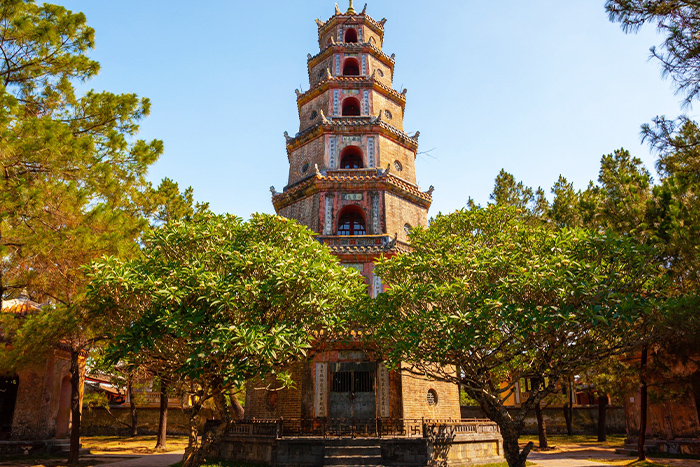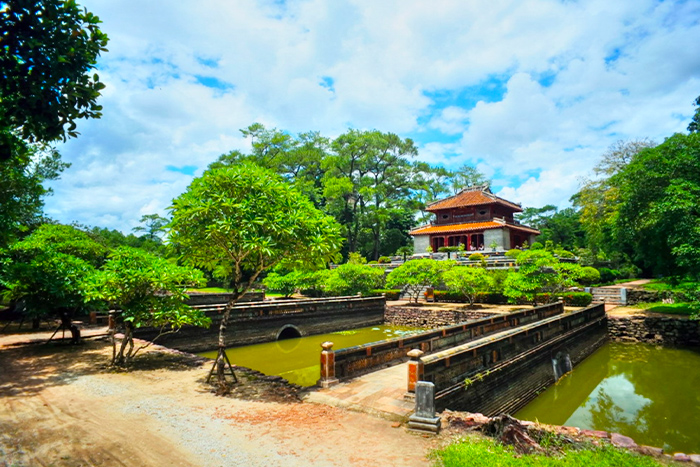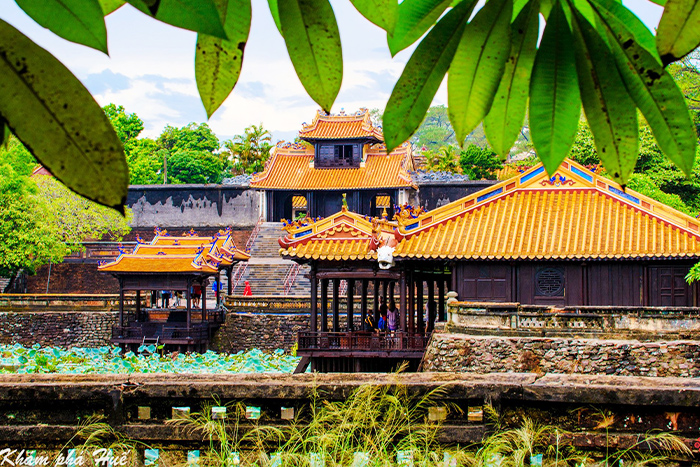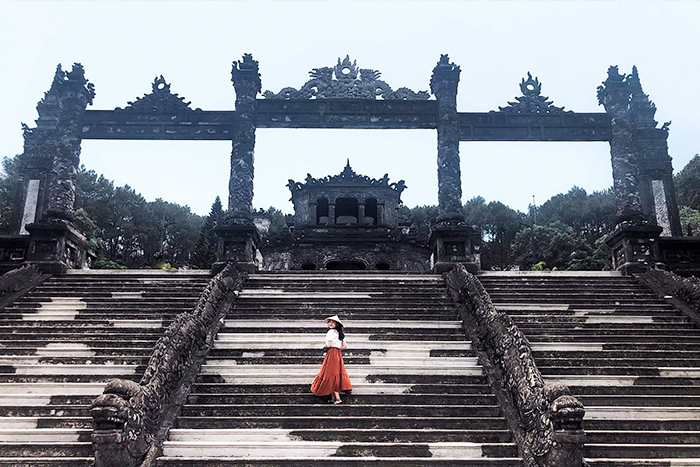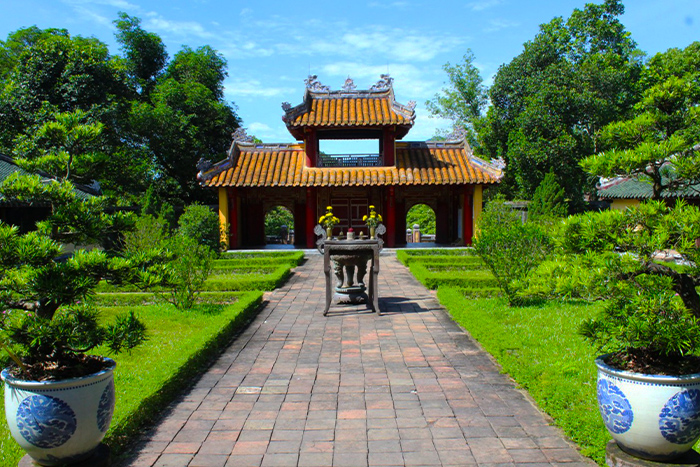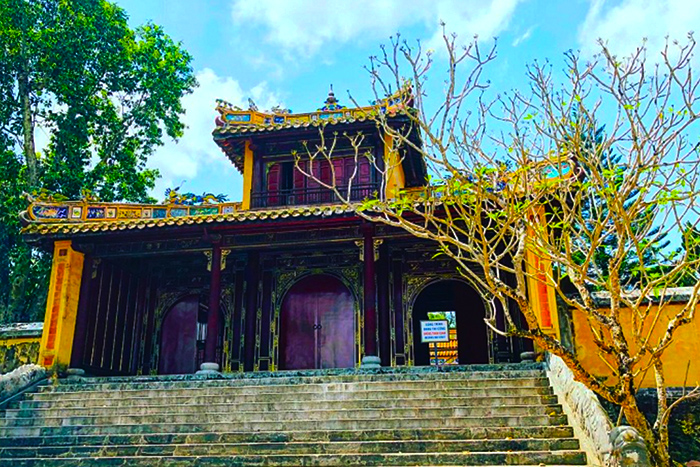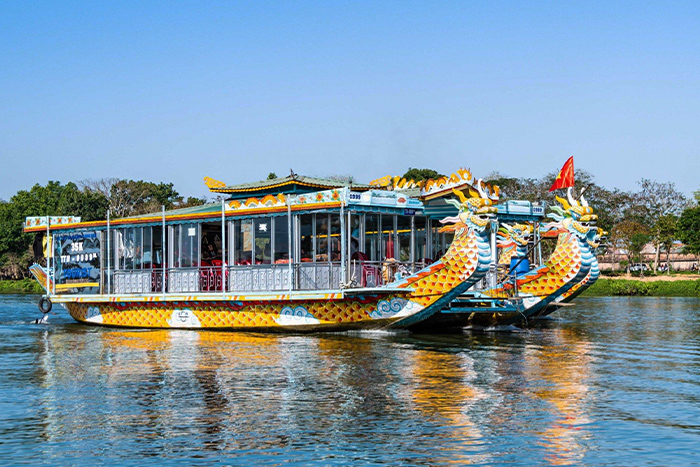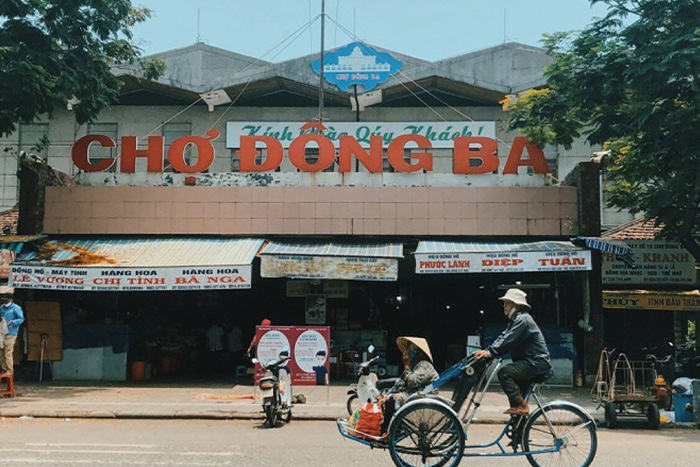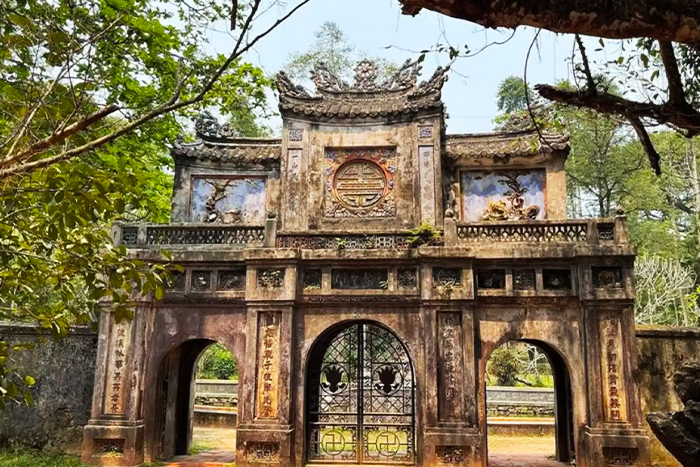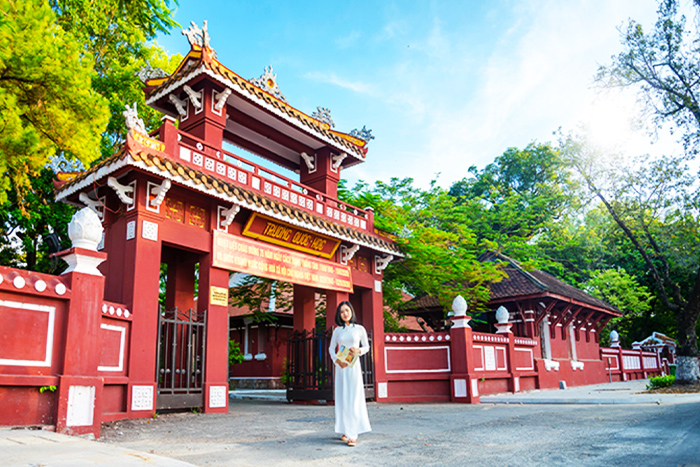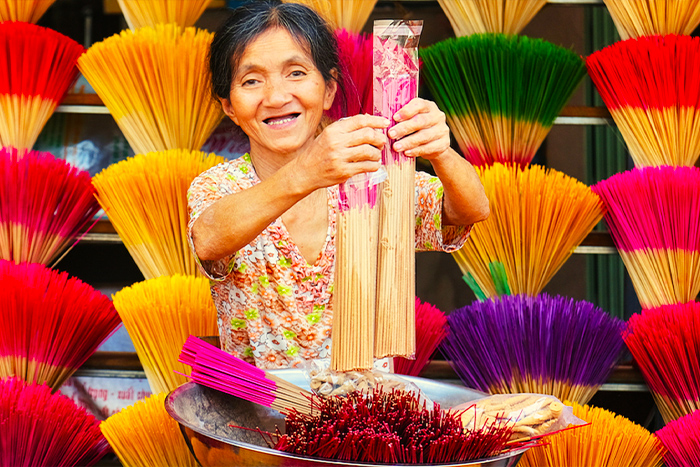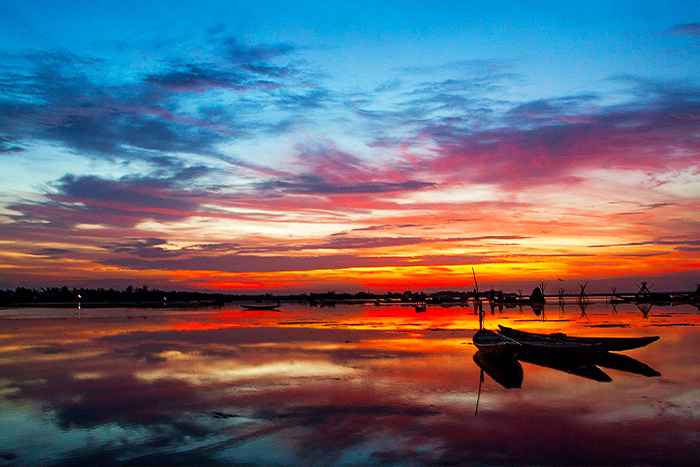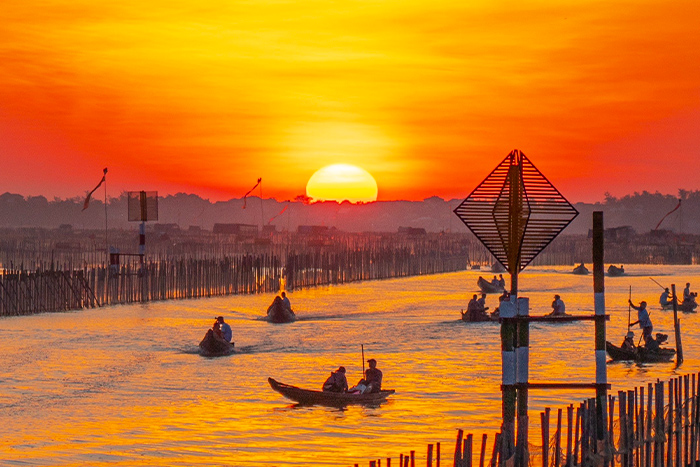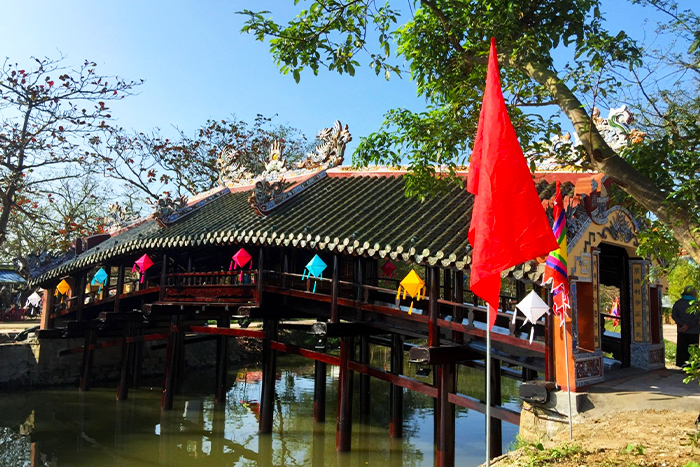Prepare to embark on an immersive journey through the captivating city of Hue, Vietnam's ancient capital adorned with timeless beauty. With a tapestry of historical wonders and cultural gems, Hue invites you to uncover its top 20 must-see tourist attractions. Join us as we embark on an unforgettable odyssey through Hue's top 20 tourist attractions, where the layers of history intertwine with the vibrant spirit of the present. Allow yourself to be captivated by the city's charm, as you walk in the footsteps of emperors, breathe in the fragrant air, and witness the legacy that has shaped this remarkable destination. Unveil the wonders of Hue, where the ancient capital awaits your exploration.
1. Hue Imperial City (The Citadel)
Nestled in the heart of Hue, Vietnam's ancient capital, lies a testament to the grandeur and sophistication of the Nguyen Dynasty—the awe-inspiring Hue Imperial City, also known as the Citadel. This monumental complex stands as a living testament to the city's regal past, beckoning visitors to embark on a journey through time and immerse themselves in a world of imperial opulence and architectural splendor.
As you approach the imposing gates of the Citadel, a sense of reverence washes over you, transporting you to an era long gone. Step through its fortified walls and prepare to be enchanted by the meticulously preserved remnants of a bygone empire. Once the seat of power for the Nguyen Dynasty, the Citadel was the political, administrative, and ceremonial heart of Vietnam for over a century.
Venture deeper into the Citadel's inner sanctum, and you'll discover the Forbidden Purple City. This secluded enclave, accessible only to the emperor, his family, and the highest-ranking officials, holds an air of mystery and intrigue. Though ravaged by war, the remnants of this once opulent residence provide a glimpse into the opulence and secrecy that surrounded the imperial court.
As you wander through the Citadel's expansive courtyards and meandering pathways, let your imagination transport you to a time when the air was filled with the sound of royal processions, the whispers of courtiers, and the fragrance of incense. Uncover the stories of emperors who ruled with authority and grace, leaving their indelible mark on Vietnamese history.
Today, the Hue Imperial City stands proudly as a UNESCO World Heritage site, a living testament to the nation's cultural heritage and a testament to the resilience of the Vietnamese people. Despite the ravages of time and conflict, ongoing restoration efforts ensure that the Citadel's magnificence continues to inspire and captivate visitors from around the globe.
2. Then Mu Pagoda
Rising gracefully above the surrounding landscape, this seven-tiered pagoda has become an iconic symbol of the city, captivating visitors with its ethereal beauty and profound spiritual significance.
Legend has it that in the early 17th century, a celestial lady appeared on the hill overlooking the Perfume River, foretelling the construction of a pagoda that would bring prosperity and harmony to the land. In fulfillment of this prophecy, Thien Mu Pagoda was built, becoming a place of worship, contemplation, and enlightenment.
As you approach the pagoda's entrance, a sense of serenity washes over you. The air is imbued with the delicate fragrance of incense, and the gentle melodies of Buddhist chants caress your ears. The pagoda's name, Thien Mu, meaning "Heavenly Lady," evokes a divine presence that permeates the atmosphere, inviting you to connect with a higher spiritual realm.
Each of Thien Mu's seven tiers represents a different reincarnation of Buddha, with each level adorned with intricate statues, ornate carvings, and vibrant hues. As you ascend the pagoda, the view unfolds, revealing breathtaking panoramas of the surrounding landscape. The Perfume River meanders gracefully below, while the verdant hills and lush foliage provide a tranquil backdrop, creating a scene of sublime beauty.
Beyond its architectural splendor, Thien Mu Pagoda holds a significant place in Vietnamese history. It played a pivotal role in the country's Buddhist movement, becoming a center of protest against social injustices during the 1960s. The self-immolation of the monk Thich Quang Duc in 1963, in protest against the religious repression of the time, added to the pagoda's historical significance and its resonance as a symbol of resilience and compassion.
3. Tomb of Minh Mang
Deep within the verdant landscapes surrounding Hue, Vietnam, lies a majestic testament to the regal heritage of the Nguyen Dynasty—the Tomb of Minh Mang. This remarkable mausoleum stands as a magnificent tribute to Emperor Minh Mang, renowned for his profound influence and enlightened rule.
Commissioned by the emperor himself and completed in 1843, the tomb embodies the balance and harmony that defined Minh Mang's reign. Its sprawling grounds span over 18 hectares, featuring a sophisticated fusion of traditional Vietnamese and Chinese architectural styles. The majestic gateways, intricately carved steles, and sacred courtyards pay homage to the emperor's illustrious legacy.
As you meander through the tomb's meticulously landscaped gardens, the tranquil beauty of the surroundings captivates your senses. Meandering pathways, adorned with ancient trees and delicate flowers, guide you towards the central area, where the emperor's final resting place lies. Marvel at the opulent ceremonial buildings, including the Honor Courtyard and the Stele Pavilion, which showcase the splendor and refinement of the Nguyen Dynasty.
At the heart of the tomb complex, the burial chamber of Emperor Minh Mang awaits. Here, amidst an atmosphere of profound reverence, lies the final resting place of the emperor, his spirit forever connected to the natural wonders that surround him. The design and orientation of the tomb reflect Minh Mang's devotion to the principles of Feng Shui, ensuring harmony between the imperial legacy and the environment.
As you explore the tomb, you'll also encounter smaller structures, such as the Sung An Temple and the Minh Lau Pavilion, which serve as places of worship and contemplation. These architectural gems provide a glimpse into the emperor's spiritual beliefs and the ceremonial rituals associated with his burial site.
The Tomb of Minh Mang stands not only as a testament to the emperor's reign but also as a reflection of Vietnam's rich cultural heritage. Recognized as a UNESCO World Heritage site, it embodies the nation's commitment to preserving its imperial legacy and sharing it with the world.
4. Tomb of Tu Duc
- Address: Dong Ba Bridge, Thuong Village, Hue City, Thua Thien Hue, Vietnam
- Entrance ticket price: 150,000 vnd / adult; 30,000 vnd/ children
- Opening hours: 7:00 - 17:30 (every day)
- Google Map: https://goo.gl/maps/yK9pgZXz5CqAiYLEA
As you approach the tomb's entrance, you are greeted by an air of quiet majesty. The vast complex spans over 12 hectares, encompassing landscaped gardens, elegant pavilions, serene lakes, and ornate temples. The architectural design showcases a harmonious blend of traditional Vietnamese and Chinese influences, reflecting the emperor's cosmopolitan outlook and appreciation for cultural diversity.
Wander through the meticulously landscaped gardens, where ancient trees provide shade and fragrant flowers add bursts of color. Tranquil ponds mirror the surrounding greenery, creating a serene atmosphere that invites introspection and contemplation. Each element of the tomb's design, from the meandering pathways to the strategically placed structures, contributes to a sense of balance and harmony.
Discover the opulent structures that adorn the tomb complex, such as the Luu Khiem Lake, where the emperor once took leisurely boat rides to seek solace amidst nature's embrace. Marvel at the majestic stele pavilion, adorned with inscriptions that immortalize Tu Duc's accomplishments and ideals. Step into the Hoa Khiem Palace, an exquisite example of imperial architecture, which served as the emperor's residence during his visits to the tomb.
At the heart of the complex lies the burial chamber, the final resting place of Emperor Tu Duc. As you enter this sacred space, an air of reverence envelops you. Intricately decorated altars and commemorative tablets pay homage to the emperor, while the surrounding lush vegetation creates a tranquil ambiance that invites quiet contemplation.
Beyond its architectural grandeur, the Tomb of Tu Duc holds a deeper significance as a reflection of the emperor's poetic spirit. Tu Duc was known for his love of literature and the arts, and his tomb stands as a poetic representation of his romantic ideals. The tomb's design and intricate details were meticulously chosen to create a harmonious fusion of art, nature, and spiritual symbolism.
5. Tomb of Khai Dinh
- Address: Thuy Bang commune, Huong Thuy district, Hue, Thua Thien Hue, Vietnam
- Entrance ticket price: 150,000 vnd / adult; 30,000 vnd/ children
- Opening hours: 7:00 - 17:30 (every day)
- Google Map: https://goo.gl/maps/N7vpePFJCveoxorQA
Perched majestically on the hills of Chau Chu, near Hue, Vietnam, the Tomb of Khai Dinh stands as a mesmerizing testament to the flamboyant taste and creative vision of Emperor Khai Dinh. This architectural masterpiece, completed in 1931, showcases a captivating blend of Eastern and Western influences, embodying the opulence and grandeur of the Nguyen Dynasty.
Approaching the tomb's entrance, one is immediately struck by its imposing presence. Designed by the emperor himself, the tomb's exterior is an intricate fusion of Vietnamese architectural elements and European aesthetics. The monument rises dramatically, with its ornate gates and staircases leading to a realm of splendor awaiting discovery.
Step inside the tomb's inner sanctum and prepare to be transported into a world of breathtaking beauty. The main hall, known as the Thien Dinh Palace, unfolds like a magnificent treasure trove. Intricate dragon motifs, crafted with meticulous detail, adorn the columns, while the ceiling dazzles with an elaborate mural depicting celestial scenes. Gilded decorations and vibrant colors combine to create an ambiance of regal magnificence.
The Tomb of Khai Dinh not only reflects the emperor's extravagant taste but also his desire to bridge the gap between tradition and modernity. Known for his appreciation of the arts, Khai Dinh was a patron of literature and music, and his tomb serves as a testament to his dedication to artistic expression. The fusion of styles within the tomb reflects his vision to marry Vietnamese cultural heritage with the influences of a changing world.
6. Tomb of Gia Long
- Address: Huong Tho, Huong Tra, Thua Thien Hue, Vietnam
- Entrance ticket price: 100,000 vnd / adult
- Opening hours: 7:00 - 17:30 (every day)
- Google Map: https://goo.gl/maps/1Z9ykcVNpUSyrYLHA
Located in Huong Tho Commune, on the outskirts of Hue, the Tomb of Gia Long offers a tranquil sanctuary amidst lush gardens and serene surroundings. As you approach the tomb, a sense of reverence fills the air, embracing you with a serene aura that befits the final resting place of an esteemed ruler.
The tomb's design reflects the harmonious fusion of traditional Vietnamese and Chinese architectural elements, reflecting the cultural influences that shaped the Nguyen Dynasty. Intricate stone carvings, majestic gateways, and ornate decorations adorn the tomb complex, offering a visual feast for the eyes and a testament to the exquisite craftsmanship of the era.
Stepping into the tomb complex, you are greeted by a serene atmosphere, where time seems to slow down. Strolling along the pathways, lined with majestic trees and colorful flowers, you discover the main structures that comprise the tomb. The Dai Thien Tho Palace, the final resting place of Emperor Gia Long, stands as the centerpiece, exuding a sense of regality and solemnity.
Beyond the palace, various auxiliary buildings and pavilions dot the landscape, each with its own significance and purpose. The stele pavilion, housing inscriptions recounting the life and accomplishments of Emperor Gia Long, offers a glimpse into the ruler's noble endeavors and contributions. Tranquil lakes and gardens, meticulously designed to create a serene ambiance, provide spaces for contemplation and reflection.
Visiting the Tomb of Gia Long is not just an opportunity to appreciate architectural beauty, but also to gain a deeper understanding of Vietnam's history and the visionary leadership of Emperor Gia Long. It is a chance to pay homage to a remarkable figure whose reign set the foundation for the Nguyen Dynasty and influenced the course of the nation.
7. Tomb of Dong Khanh
- Address: Doan Nhu Hai, Thuy Xuan, Hue City, Thua Thien Hue, Vietnam
- Entrance ticket price: 100,000 vnd / adult
- Opening hours: 7:30 - 17:30 (every day)
- Google Map: https://goo.gl/maps/m2xu5M2UVRViHJKf7
The Dong Khanh Tomb, the last of its kind in the classic architectural style of Hue, serves as a poignant reminder of the imperial grandeur that once characterized the region. Constructed in 1889, immediately following the coronation of Dong Khanh's successor, the tomb's completion was ultimately carried out under the reign of Emperor Khai Dinh, spanning from 1916 to 1925.
As you approach the Dong Khanh Tomb, you will be mesmerized by the intricate details that adorn its structure. Elaborate motifs, delicate sculptures, and ornate stone carvings showcase the artistic mastery of the craftsmen who brought this architectural marvel to life. The tomb's design pays homage to both traditional Vietnamese elements and the imperial aesthetics of the era, inviting visitors to marvel at its splendor.
Entering the tomb complex, you are greeted by a serene ambiance that reflects the reverence bestowed upon this sacred site. Tranquil gardens, manicured landscapes, and pristine pathways lead you to the heart of the tomb, where Dong Khanh rests eternally. This hallowed space provides an opportunity for contemplation and reflection, allowing visitors to connect with the historical significance of the emperor's life and reign.
Dong Khanh Tomb not only serves as a memorial to an emperor, but it also encapsulates the tumultuous period in Vietnam's history when the nation faced external challenges and internal strife. It stands as a poignant reminder of the struggles and sacrifices endured during an era marked by colonial expansion and political turbulence.
8. Boat on the Perfume River
Taking a cruise along the Perfume River in Hue, Vietnam, is a delightful way to immerse yourself in the city's rich cultural heritage and experience the serene beauty that has captivated visitors for centuries. As the boat gently glides along the river's meandering path, you are embraced by a sense of serenity. The rhythmic sounds of the water lapping against the boat's hull, combined with the gentle breeze caressing your face, create a soothing symphony that lulls you into a state of relaxation and wonder.
As you navigate the Perfume River's gentle currents, your senses are awakened by the aromas and flavors of Hue's culinary delights. Indulge in the delectable tastes of local dishes, served onboard the cruise, as you savor the nuances of Vietnamese cuisine. The delectable flavors blend harmoniously with the sights and sounds, offering a complete sensory experience.
The journey on the Perfume River is not merely a sightseeing adventure; it is an opportunity to connect with the city's rich history and cultural tapestry. As you cruise along, knowledgeable guides share stories and legends that have shaped Hue's identity, recounting tales of emperors, warriors, and poets who have left their indelible mark on this land.
9. Truong Tien Bridge ( Trang Tien Bridge )
Spanning gracefully across the Perfume River in Hue, Vietnam, the Truong Tien Bridge stands as an iconic symbol of the city's history, resilience, and architectural splendor. This elegant bridge, with its distinct arched design, has served as a vital link between the two banks of the river for over a century, connecting not only physical landscapes but also the hearts of the people.
Constructed in 1899 during the reign of Emperor Thanh Thai, the Truong Tien Bridge was envisioned as a symbol of progress and modernity. Its construction marked a significant milestone in the city's development, bringing together the old and the new, the traditional and the contemporary. As you set foot on the bridge, you embark on a journey through time, where history and heritage intertwine with the vibrancy of the present.
As you traverse the Truong Tien Bridge, you are greeted by breathtaking views of the Perfume River and the cityscape beyond. The bridge's distinctive arches, adorned with intricate ironwork and ornate lampposts, exude a sense of elegance and grandeur. Whether bathed in the soft glow of dawn or illuminated by the city lights at night, the bridge casts a captivating silhouette against the backdrop of Hue's scenic beauty.
10. Dong Ba Market
With its bustling atmosphere and strategic riverside location, this traditional market pulsates with the vibrant life, rich culture, and time-honored customs of the people of Hue. Step into this cultural haven, and you will embark on a remarkable journey to better understand the unique essence of the local community, while creating beautiful memories in this ancient land.
Dong Ba Market presents a captivating opportunity for exploration and immersion in Hue's distinct cultural tapestry. As you wander through its expansive space, you will encounter a cornucopia of sights, sounds, and scents, each a reflection of the city's vibrant identity. It is within these market walls that you can truly grasp the pulse of Hue, witnessing the daily rhythms of its residents and gaining insight into their customs and way of life.
If you seek a shopping haven primarily dedicated to fabrics and clothes, make your way to the market's 3rd floor. Here, a myriad of outfits awaits, showcasing a fusion of traditional craftsmanship and contemporary designs. From intricate ao dai dresses to vibrant textiles, you will find a treasure trove of fashion options that embody the region's unique style and artistry.
No visit to Dong Ba Market would be complete without savoring the flavors of the region's cuisine. Indulge your taste buds in the regional specialties available, satisfying your hunger at the most affordable prices, all while ensuring impeccable hygiene and freshness. From savory street food snacks to delectable local delicacies, the market's culinary offerings will ignite your senses and introduce you to the unique flavors that define Hue's gastronomic identity.
Dong Ba Market encapsulates the essence of Hue, weaving together the threads of its history, culture, and daily life. It is a vibrant tapestry where the past meets the present, where locals and visitors intermingle, and where the heartbeat of the city is palpable. Immerse yourself in this sensory adventure, as you navigate the bustling aisles, interact with the warm-hearted vendors, and absorb the vibrant energy that permeates the market's every nook and cranny.
11. Tu Hieu pagoda
Deep in the heart of Hue city, the enchanting Tu Hieu Pagoda stands as a testament to centuries of spiritual devotion and cultural significance. Its origins trace back to the year 1747 when Emperor Tu Duc bestowed upon it the esteemed title of "Sac Tu Tu Hieu Tu," solidifying its place as a revered site of worship.
Throughout its storied history, Tu Hieu Pagoda has undergone several renovations, reflecting the unwavering reverence bestowed upon this sacred space. The triple gate, adorned with two roofed storeys and crowned with the Ho Phap statue, serves as a grand entrance that beckons visitors into a realm of tranquility and inner reflection.
Inside the pagoda's grounds, a crescent-shaped lake, meticulously constructed in 1931, adds a touch of natural beauty. Delicate lotus flowers and graceful water lilies grace the surface, creating a serene atmosphere that inspires contemplation and peace. As you wander through the pagoda's courtyards and gardens, a sense of harmony envelops you, providing respite from the outside world.
Tu Hieu Pagoda holds a significant place in Hue's history, revered not only as an ancient spiritual sanctuary but also as a center of Buddhist scholarship. It was within these sacred walls that Buddhist scriptures and discipline codes were meticulously transcribed and disseminated, carrying the wisdom and teachings of the faith to generations of followers.
12. Quoc Hoc Hue high school
Established on October 23rd, 1896, during the reign of King Thanh Thai, Quoc Hoc Hue High School holds a venerable place in the educational history of Vietnam. This esteemed institution, located in the historic city of Hue, has been a beacon of learning and intellectual growth for over a century, shaping the minds of generations and leaving an indelible mark on the nation's cultural landscape.
Originally founded through a decree by the French Resident-Superior in Indochina, Quoc Hoc Hue High School emerged as a center of academic excellence. Its mission was to cultivate young minds, instill a sense of national pride, and foster critical thinking among the youth. Throughout its existence, the school has produced a lineage of scholars, leaders, and visionaries who have played pivotal roles in shaping the destiny of Vietnam. The physical presence of Quoc Hoc Hue High School reflects its historical significance. The school's architecture embodies the traditional charm of Vietnam, with a majestic entrance gate adorned in intricate details and a two-story structure that exudes a sense of grandeur. Despite undergoing renovations over the years, the essence of its original design has been preserved, creating an atmosphere that seamlessly blends the old and the new.
Beyond its architectural splendor, Quoc Hoc Hue High School holds a special place in the hearts of the local community and the nation as a whole. Recognized as a national cultural historical relic, its halls echo with the footsteps of countless students who have walked in pursuit of knowledge and enlightenment. The school's rich heritage and commitment to academic excellence continue to inspire and shape the aspirations of future generations.
13. Thuy Bieu Village
Nestled near the heart of Hue imperial city, Thuy Bieu village beckons with its serene ambiance, sprawling grapefruit orchards, and centuries-old houses steeped in history. The name Thuy Bieu is believed to have originated from the village's geographical makeup, with three sides embraced by the meandering Perfume River (Thuy, meaning water) and the lush surroundings resembling the shape of a gourd (Bieu). This idyllic village thrives on rice cultivation, gardening, and the art of traditional handicrafts, creating a harmonious blend of livelihoods deeply intertwined with nature.
As you venture into Thuy Bieu village, you will have the opportunity to explore the enchanting garden houses that dot its landscape. These architectural marvels are emblematic of Hue's cultural heritage, and each one holds a unique story within its walls. Some of these houses have stood for centuries, carrying the echoes of the past and offering glimpses into a bygone era. Immerse yourself in the charm of these well-preserved structures as you step back in time and witness the timeless beauty of their design.
Beyond its architectural splendor, Thuy Bieu village invites you to revel in its tranquil atmosphere, immerse yourself in the rhythms of daily life, and savor the authentic charms of Vietnamese countryside living. Wander through the village's meandering paths, engage with the welcoming locals, and witness the time-honored traditions that have shaped this community.
14. Thuy Xuan incense-making village
As you step into Thuy Xuan village, the air becomes infused with the captivating scent of incense. The journey of creating incense begins with a meticulous selection of five essential ingredients: cinnamon, cardamom, clove, anise, and eucalyptus. These precious elements are carefully blended with water to form the aromatic "dough" that is then delicately wrapped around thin bamboo sticks sourced from Nam Dong district, Binh Dien commune, or Phong Son commune. The sun-drying process adds an additional layer of traditional craftsmanship, setting Thuy Xuan incense apart from modern mass production methods. The resulting incenses boast a vibrant array of scents, ranging from the warm embrace of cinnamon to the invigorating essence of lemongrass oils. Crafted with eco-friendly materials, these locally-made incenses showcase a brilliant yellow hue and emit a delightful aroma that fills the air.
Thuy Xuan's craft offerings have expanded beyond incense, with local artisans now showcasing a variety of souvenirs. From intricately lacquered paintings to beautifully crafted fans and exquisite brocades, these treasures embody the village's artistic heritage. While in the past, Thuy Xuan incense primarily catered to domestic demands, it has now found its way into international markets, becoming a cultural ambassador that represents the region's rich traditions.
15. Tam Giang lagoon
As the largest lagoon in Southeast Asia, Tam Giang Lagoon unfolds like a shimmering tapestry, showcasing the harmonious dance between land and water. Tam Giang Lagoon is a haven for nature enthusiasts and explorers seeking a peaceful retreat. The lagoon's expanse of serene waters, adorned with lush mangrove forests and vibrant aquatic life, creates a mesmerizing panorama that awakens the senses. The interplay of light and shadow over the calm surface of the lagoon paints a breathtaking scene, especially during the golden hours of sunrise and sunset, when the sky is ablaze with hues of orange and pink.
Tam Giang Lagoon not only offers a breathtaking natural landscape but also serves as a window into the rich cultural heritage of the region. Along its shores, you'll find traditional fishing villages where artisans create exquisite handicrafts and delicate seafood delicacies. Exploring these villages allows you to witness the traditional craftsmanship of net weaving and the intricate art of making fishing traps, providing a glimpse into the age-old traditions that have shaped the local communities.
16. Lang Co beach
Lang Co Beach emerges as a pristine oasis, inviting travelers to immerse themselves in its serene ambiance and bask in its tropical splendor. With its pristine white sands, crystal-clear turquoise waters, and lush green landscapes, Lang Co Beach offers a picturesque escape that captivates the senses and rejuvenates the soul.
Located between the vibrant cities of Hue and Da Nang, Lang Co Beach boasts a tranquil setting that remains relatively untouched by the bustling tourist crowds. As you step onto the soft sands and feel the gentle caress of the sea breeze, you'll be transported to a world of serenity and natural beauty. The beach stretches for kilometers along the coast, offering ample space to unwind, relax, and soak up the sun's warm embrace. Lang Co Beach is renowned for its unspoiled natural surroundings, creating an idyllic backdrop for both adventure and relaxation. The azure waters beckon water enthusiasts to dive in and explore the vibrant underwater world teeming with colorful marine life. Whether you're snorkeling, swimming, or simply floating in the gentle waves, the tranquility of the sea envelops you, providing a sense of blissful escape.
17. Hue Royal Antiquities Museum
Nestled within the heart of Hue, the former imperial capital of Vietnam, lies the Hue Royal Antiquities Museum, a captivating treasure trove that unveils the grandeur and legacy of the country's imperial history. This magnificent museum stands as a testament to the rich cultural heritage and regal traditions that once graced the royal court.
The museum's meticulously curated exhibits offer a captivating journey through the centuries of Vietnam's royal heritage. Ancient statues, royal garments, intricate jewelry, and precious artifacts are carefully displayed, allowing visitors to marvel at the exquisite craftsmanship and artistic mastery that characterized the imperial court.
Each artifact within the museum tells a story, offering insights into the lives and rituals of the Nguyen dynasty, the last ruling family of Vietnam. From imperial thrones and ceremonial costumes to religious artifacts and ancient manuscripts, the Hue Royal Antiquities Museum presents a comprehensive narrative of the royal court's splendor and cultural significance.
Wandering through the museum's halls, you can't help but be awestruck by the attention to detail and the symbolism woven into every object on display. The ornate carvings, delicate porcelain, and vibrant paintings reflect the profound reverence for aesthetics and spirituality that permeated the imperial culture. For those seeking to delve into the depths of Vietnam's regal history and immerse themselves in a world of grandeur and elegance, the Hue Royal Antiquities Museum is an unmissable destination.
18. Chuon lagoon
Chuon Lagoon (also known as Cau Hai Lagoon) holds a prominent place on the tourist map of Hue, captivating visitors with its enchanting allure. Stretching across approximately 100 hectares, this expansive brackish water lagoon serves as a captivating destination for those seeking a unique eco-tourism experience.
The panoramic vista of Chuon Lagoon is a spectacle to behold, with its vast expanse of shimmering waters and the graceful glide of boats across its surface. The scenery is further enhanced by the presence of flute barriers, a distinctive aquaculture system that adds a touch of intrigue and charm to the lagoon's landscape. These barriers serve not only as a means of cultivating aquatic life but also as a visual marvel that showcases the harmonious coexistence between humans and nature.
Amidst this picturesque setting, one can find the charming bamboo shacks that dot the lagoon's shores. These humble abodes, measuring around 5 square meters, serve as the dwellings for local fishermen, as well as resting places for weary travelers. Stepping inside these quaint structures, visitors can immerse themselves in the rustic ambiance, basking in the serenity of the lagoon, gazing at the twinkling stars above, and savoring the delights of the local cuisine.
Chuon Lagoon is not merely a feast for the eyes; it is a destination that offers a myriad of experiences. For nature enthusiasts, bird-watching amidst the lagoon's abundant wildlife provides an opportunity to witness the graceful flight of resident and migratory birds. Adventurers can embark on thrilling boat rides, exploring the labyrinthine channels and immersing themselves in the tranquility of the surrounding mangrove forests.
19. Thanh Toan tile-roofed bridge
Originally built during the reign of Thieu Tri, the bridge stands as a testament to the pioneering spirit and community solidarity of the people of Thanh Thuy village. Its construction was made possible through the generous contribution of Ms. Tran Thi Dao, a niece of the esteemed Tran family, who selflessly donated her own funds to bring this architectural gem to life.
Adorned with the classic "Thuong gia, ha kieu" (the house is above, the bridge is beneath) design, Thanh Toan tile-roofed bridge is an exquisite example of Vietnamese architectural finesse. Spanning 18.75 meters in length and 5.82 meters in width, the bridge features wooden platforms and railings on both sides, providing a serene space for visitors to rest and take in the surrounding beauty. Its roof, adorned with delicate tiles, is divided into seven compartments, with the central compartment dedicated to the worship of Ms. Tran Thi Dao, honoring her benevolent spirit and contribution to the bridge's construction.
Throughout its existence, Thanh Toan tile-roofed bridge has undergone several renovations, ensuring its preservation for future generations. Although slight modifications have been made to the construction materials over time, the essence and architectural integrity of the bridge have remained intact, allowing visitors to truly appreciate its timeless allure.
20. Sinh village ( Lai An Village)
Since the 15th century, Lai An village has been a bustling hub of trade and a cultural center in the ancient capital. The lively trading scene in Lai An village was vividly described by Duong Van An in his writings, depicting the bustling Bao Vinh Bridge with its horses and carriages, and the crowing of roosters in Lai An village that urged merchants to compete for profit. The village has long been known for its vibrant market and its role as a hub of economic activity.
One of the cherished traditional crafts of Sinh Village is the art of woodblock painting, which serves both religious and spiritual purposes. The intricate Sinh paintings feature a diverse range of approximately 50 themes, capturing scenes of social activities and ancient beliefs. Stepping into Sinh Village, visitors will have the opportunity to witness the exquisite craftsmanship and learn about the significance of these unique artworks.
Sinh Village is also renowned for its vibrant festivals, particularly the celebrated animal festival that draws visitors from near and far. This captivating event showcases the village's deep-rooted cultural traditions and allows participants to immerse themselves in the joyous atmosphere of lively performances and colorful displays.
As you explore Sinh Village, the tranquil beauty of the Perfume River and the authenticity of village life will captivate your senses. Immerse yourself in the vibrant history, exquisite artwork, and cultural festivities that make Sinh Village a treasured gem in the Hue region. Experience the rich traditions and warm hospitality of the locals as you delve into the unique heritage of this enchanting destination.
Hue, Vietnam is a destination that captivates the senses and leaves travelers with a sense of awe and wonder. With its rich history, cultural treasures, and breathtaking landscapes, there is an abundance of unforgettable experiences to be had in this enchanting city. Hue is not just a place to visit; it's a destination that invites you to feel its heartbeat and become part of its story. Let the allure of Hue sweep you off your feet, as you uncover its hidden gems and create cherished memories that will last a lifetime.

